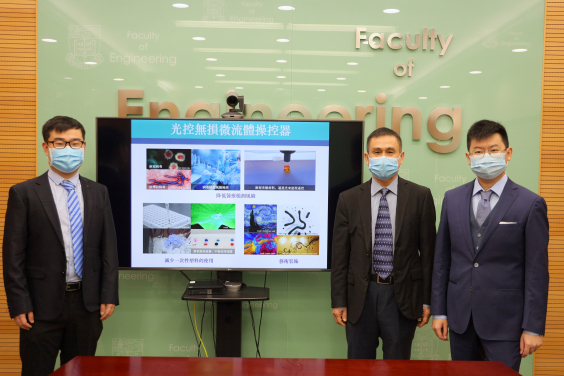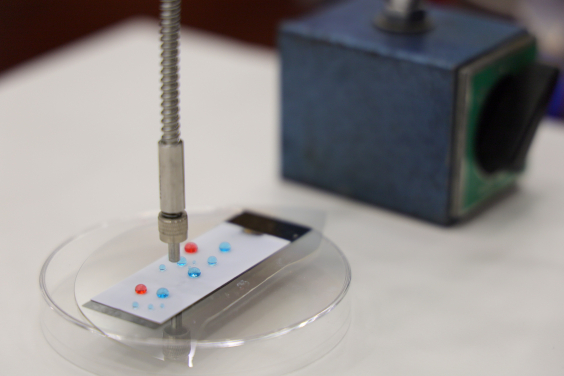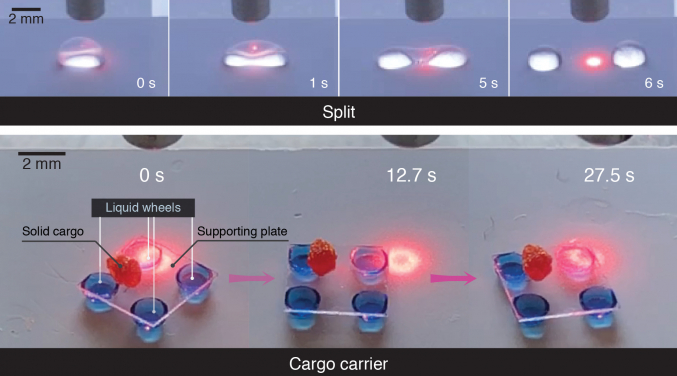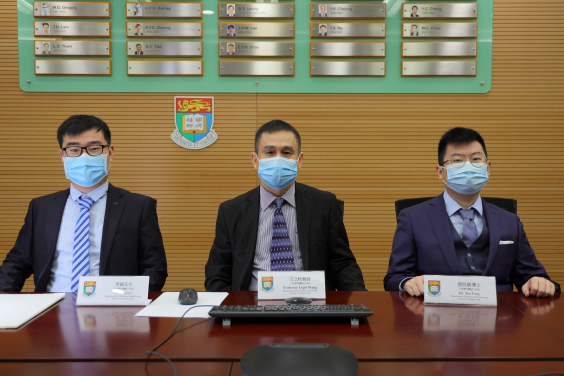Media
HKU Engineering research team invents novel light-controlled contamination-free fluidic processor for advanced medical and industrial applications
08 Dec 2020
A mechanical engineering research team at the University of Hong Kong (HKU) has invented a novel light-controlled, contamination-free fluidic processor, which can serve as a useful tool to greatly reduce the risk of infection of front-line medical workers in testing virus or bacteria in big pandemics like the current COVID-19 pandemic, and to minimise the risk of contamination during the process.
The new technology has been published in Science Advances in an article titled “Photopyroelectric Microfluidics”, co-authored by graduate student Mr Wei Li, postdoctoral researcher Dr Xin Tang and Chair Professor Liqiu Wang at the Department of Mechanical Engineering, Faculty of Engineering, HKU.
Precision manipulation of various liquids is essential in many fields. The team innovatively uses light as a stimulating force, allowing contactless manipulations in moving, merging, dispensing and splitting liquids, on a specifically designed photo-responsive platform. The platform is non-toxic and non-sticky to all fluids, making it an ideal contamination-free fluidic processor.
Professor Wang said the first applications of the new technology can be in biomedical testing and diagnosis, with the aim of lowering the risk of contamination and infection in the process.
“Testing infectious viruses and bacteria is highly risky, sometimes even fatal. A blood droplet from an Ebola patient can infect medical workers through the skin. For diagnosis, medial workers have to crash, filter and purify a patient’s blood sample to obtain the virus’s genetic materials. This series of operations, very often in a fluidic medium, is highly infectious. Moreover, fluids stick to surfaces, which will contaminate containers and handling tools, causing potential dangers if the medical wastes are not properly managed.” He said.
According to WHO reports, healthcare workers are 21 to 32 times more likely to be infected with Ebola and nearly 14% of COVID-19 reported cases are among healthcare workers. Moreover, it is estimated that disposable plastics worth US$20 billion are consumed in testing annually. The used plastics are left with potentially infectious or toxic residues and hazardous wastes that cost another US$10 billion to handle.
“We hope the newly-invented technique can reduce and even replace the usage of disposable plastics in the biomedical and pharmaceutical industries. The light-control device outperforms its electrical counterpart in the market in terms of operational precision and convenience, whereas the cost is only one-hundredth of it.” Professor Wang said.
The key technology of the light-controlled fluidic processor is a two-layer photo-responsive platform. With a thickness of only 2mm, it is portable and easy to handle. Its superomniphobic surface interfaces fluids in a frictionless manner, like dew drops rolling on a lotus leaf; and a photothermal pyroelectric layer, which senses the light stimuli and converts it into a force that move, split and dispense fluids.
It has great potential in advanced research and applications in DNA analysis, proteomics, cell assay and clinical diagnosis, chemical synthesis and drug discovery. It can handle a wide spectrum of liquids such as water, alcohol, alkanes, and particularly silicone oil, which is particularly challenging because of its ultra-low surface tension. Its maneuverable fluid volume can be from 1000 μl to tiny droplets at 0.001 μl, i.e. about 0.02% of the volume of blood in a mosquito bite, which is 100 times smaller than that manipulated by its electrical counterpart.
“The device functions as a “magic” wetting-proof hand to navigate, fuse, pinch, and cleave fluids on demand, enabling cargo carriers with droplet wheels and upgrading the limit of maximum concentration of deliverable protein by 4000-fold.” Professor Wang said.
The team will seek to integrate the platform with artificial intelligence (AI) system to work out a fully automatic system for liquid processing. In future, gene editing can be done with the click of a button, instead of repeated pipetting.
The paper in Science Advances: https://advances.sciencemag.org/content/6/38/eabc1693
Please click here for a short video on the fluidic processor:
About HKU Faculty of Engineering
The Faculty of Engineering is one of the founding Faculties of The University of Hong Kong established in 1912. Since its foundation, the Faculty has kept pace with developments in the engineering world and is always at the forefront of engineering research, evolving into one of the largest Faculties at the University with five departments providing undergraduate, postgraduate and research degrees in a wide range of important fields of modern engineering, technology and computer science.
The Faculty aims at providing an all-round education for students, equipping graduates not only with knowledge of cutting-edge technology, but also excellent communication and social skills, an innovation mindset, a lifelong learning attitude, professional integrity and international exposure. For more information, visit https://engg.hku.hk.
Media enquiries:
Ms Celia Lee, Faculty of Engineering, HKU (Tel: 3917 8519/9653 1040; Email: leecelia@hku.hk) or
Mr Heng Cheng, Faculty of Engineering, HKU (Tel: 3917 1924; Email: hengc@hku.hk)




